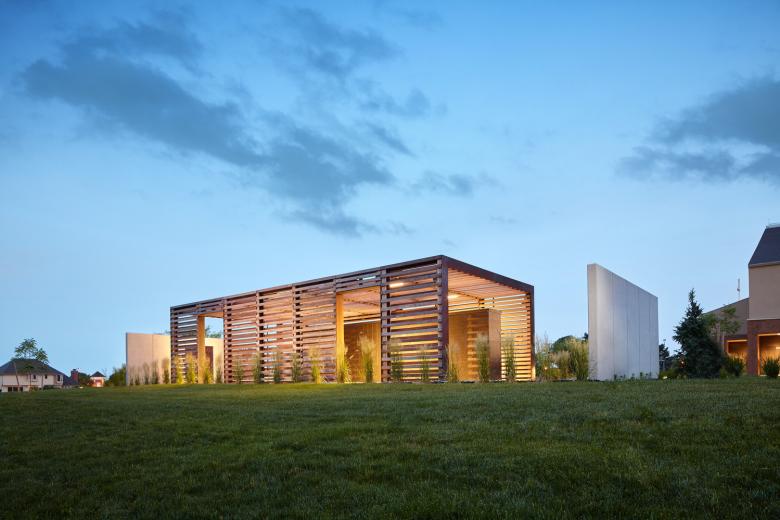U.S. Building of the Week
St. Mark’s United Methodist Church Columbarium
BVH Architecture
7. January 2019
Photo: William Hess
Located almost ten miles southeast of Downtown Lincoln, Nebraska, St. Mark’s United Methodist Church sits appropriately amidst a sea of parking. This suburban context offered a challenge to BVH Architecture when they designed a new columbarium sited on the edge of the parking lot. Wood slats mounted on self-weathering steel offer some privacy and intimacy for the services held within its walls. The architects answered a few questions about the project.
Location: Lincoln, Nebraska, USA
Client: St. Mark’s United Methodist Church
Architect: BVH Architecture, Omaha, NE
Design Principal: Dan Spiry
Project Architect: Michael Harpster
Structural Engineer: Lange Structural Group
MEP/FP Engineer: Engineering Technologies, Inc.
Civil Engineer: Olsson Associates
Site Area: 3,500 sf
Building Area: 1,000 sf
Photo: William Hess
What were the circumstances of receiving the commission for this project?
BVH Architecture had previously completed the design of the St. Mark’s United Methodist Church sanctuary. As a result of the success of this project, the church reached out to BVH when it identified the need for the design and construction of a new columbarium.
Please provide an overview of the project.
Given a limited construction budget and a project site surrounded on three sides by a parking lot, the design team was asked to create a secluded space to serve as a memorial and columbarium for the congregation at St. Mark’s United Methodist Church. The resulting design employs simple strategies of layering, procession, and materiality to craft an intimate, contemplative experience within an otherwise open, public environment.
Photo: William Hess
A granite-clad wall placed along the central axis of the site serves as the project’s primary programmatic element. The wall houses over three hundred individual niches in which cremated remains are interred. The wall functions as the backdrop for on-site interment ceremonies and also serves as a memorial, with the names of those interred etched into the face of the granite. A small bench located just south of the primary niche wall will eventually serve as the foundation for additional niche cabinets to be installed in the future.
Enveloping the granite niche wall are a series of self-weathering steel armatures clad with ipe wood slats. This system of steel armatures and horizontal slats conceals the memorial niches from public view and provides visitors to the columbarium with visual separation from the surrounding parking lot. This element also provides partial shade in an otherwise open environment. Both performances of the armatures - i.e. providing visual separation and more comfortable environmental conditions - aid in establishing a contemplative, reflective environment for those visiting loved ones interred in the niche wall.
Photo: William Hess
To meet the project’s budgetary limitations, the design team sought to reduce the labor costs associated with the shroud element by utilizing shop-fabricated steel elements and simple, repetitive detailing for the installation of the wood slats. While the detailing of the slat assembly remains simple, slight variations in slat spacing allow the wood slats to respond to variations in desired levels of internal privacy and give the structure a subtle sense of ornamentation.
The north and south ends of the ipe shroud remain open to small memorial rock gardens that are terminated by cast-in-place concrete walls. These walls restrict views to the surrounding parking lots while allowing the garden areas to remain open to the sky above. Currently, the south rock garden contains a self-weathering steel plate cantilevered out of the ground that is etched with a scripture passage. The north garden remains empty and will serve as the site for future memorial donations of sculpture or landscaping.
Photo: William Hess
What are the main ideas and inspirations influencing the design of the building?
Considerations of the passage of time and its effects drove the thinking of the design. Natural materials were incorporated into the project and left unfinished, allowing these materials to weather and change over time and to provide a visual reminder or index of the passage of time.
Drawing: BVH
How does the design respond to the unique qualities of the site?
The project sits amidst a paved parking lot serving the larger church building on site. In order to create an intimate, reflective environment within this otherwise open and uninviting space, natural materials were used to construct a semi-opaque enclosure that helps to provide visual and acoustic privacy while also offering a sense of warmth for those visiting the columbarium.
Drawing: BVH
How did the project change between the initial design stage and the completion of the building?
The project had to be scaled down from its original size in order to meet budgetary constraints. Because the design is based on a repeated module of the structural frame and ipe enclosure, the design was easily able to be reduced in size without negatively impacting the quality or character of the completed project.
Email interview conducted by John Hill.







